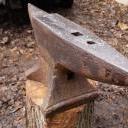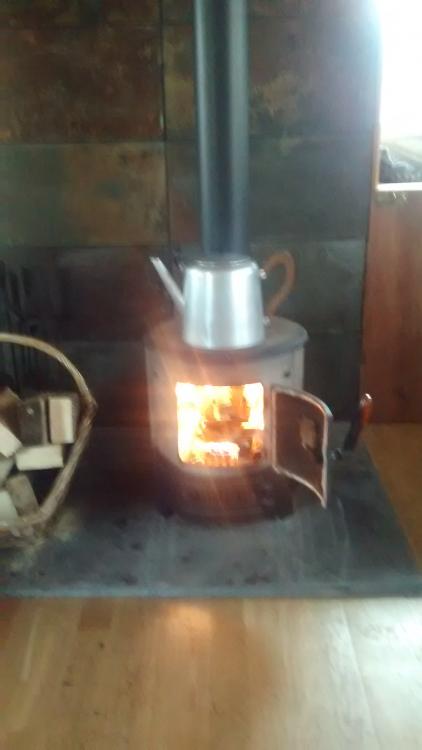Leaderboard
Popular Content
Showing content with the highest reputation on 03/07/17 in all areas
-
2 points
-
So we have been in the house about 5 months now and though I'd share a bit about how we are controlling the heating. As a recap, we have a MBC build house and slab, not the twin wall all pumped cellulose version but slightly less insulating and costly. Our wall makeup from outside to inside is: 20mm larch hit and miss cladding or Pavex on render board. 50mm battens Some sort of black membrane 9mm OSB 140mm stubs filled with 150mm Warmcell Airtight membrane 50mm PIR insulation 35mm battens 12mm plaster board Roof is: Evalon VSK single membrane 9mm OSB 25mm batten Non tenting membrane 18mm OSB 300mm I hoisted filled with cellulose insulation. Airtight membrane Battens to create 100mm service cavity 12.5mm plasterboard Floor is: 300mm polystyrene insulation 100mm concrete with UFH pipes imbedding in it. Heating controls So I thought I had found an off the shelf thermostat with a floor sensor from Wunda, but it turns out that the floor sensor is there to limit the screed temperature and somehow the one I have doesn't work as it can't 'see' it even though it's a wired connection. Turns out the thermostat has a sensor on it, whole whole house is being controlled from one air sensor in the open plan living room about 1.5m off the ground. This is set to be 24c (prob a couple of degrees above actual temp due to an offset function in programmer) during the day and 21 overnight so it doesn't call for heat. UFH setup I have a gas combi boiler heating a 70l buffer store, set up so that the boiler is set to keep this store at a certain temperature - currently about 35c. It is set to do this all the time as I haven't got round (and prob won't as set up seems to work) to replacing the duff manual timer on the boiler. Tank is double sprayed and has about 100mm on insulation on it. A pump feeds water to the UFH circuits and is activated by the thermostat in the open plan rooms, there is a bypass in case the UFH circuit thermostat (looks like a TRV on a radiator) is closed. There is also a NC (normally closed) valve on the return side of the UFH manifold, this too is connected to the room thermostat. The pump at the buffer was not in original design and this was the mechanism to allow the buffer water into the UFH circuits - but plumber said pump on manifold wasn't 'sucking' water from the buffer, just pumping it round the circuits. So pump at buffer was added as a quick fix. Flow rate on the 6 UFH circuits all set the same at about 2l/min (and due to someone losing a piece of paper I have no idea which circuit goes were) and both pumps set to lowest setting. Pump on UFH was all all the time but now off 6 hrs over night, the 2hrs first thing in the morning and then off 30mins then on 30 mins for rest of day. I find the temperature on the TRV set to about 30c and find that the return temperature is always about 5c less, but have only tested that from about 28c - 35c on the feed side. So far have found that works great, house nice steady temperature, I were a t-shirt and if boys (7&4) are running about they have to strip off their tops, so prob could go down a bit, but after having 8 winters in a detached solid walked house which was like a fridge I'm liking this. Have noticed the last couple of weeks that it sometimes getting a bit warm, our living room faces north so don't get sun there but bedrooms face SW so they can get warm, but hoping when sun gets higher this won't be as much as an issue as we have fairly deep waves (300mm). Been sending gas and electric meter readings off monthly to see if all this planning is working and for Nov - Jan gas was about £30 and Elec £50 a month. Feb was £28 and £48. That is with 2/3 adults and 2 kids. Be interesting to see what they are once I turn off the pumps and turn boiler to summer mode, would really like to see what the heating cost per month is.1 point
-
Never changed a vaillant to lpg but changed other boilers. What exactly do you mean by new jets? Last one we changed was a worcester (few years ago now), it was a chip in the main pcb but it was a rite pita to set up. If ur sparkie is gas safe and has the correct equipment then fine but if not I think I would pay vaillant for a engineer. Just had a quick look at kit it does look like a jet. Sorry.1 point
-
Unless your sparky is Gas Safe registered you will not only invalidate the warranty you will be breaking the law ..! (Or he will..) LPG needs setting up properly as the pressure and flow are different to Nat Gas. Do the right thing and spend the money..!!1 point
-
I've seen maybe 20 stoves up at our hutting fraternity. In general...cold weather, poor insulation...folk want maximum output. My observations are that new stoves which equals very expensive; are fantastic to look at ( big glass and slow flickering burn) but don't pump out much heat. No great surprise as most have ceramic or fire brick lining on the inside to aid the fire temperature so less heat radiating through the stove wall. Mine on the other hand was £250 from machine mart and rated at 11kw. Probably because it's just 4 bits of cast iron bolted together. However it is fantastic for keeping the place toasty. Internal temperature is regulated by a combination of fuel type, control of the rudimentary stove vent and choosing which windows to open and how wide.? I'd call it stove art. Putting it in the middle of the floor must help too, instead of heating up the inglenook walls...horses for courses passivers?1 point
-
Andrew, how hot your slab gets depends of your UFH system. Conventional UFH systems in normal houses might heat the floor up to 30°C or more. However the rule of thumb is that your floor will chuff out 7-10W/Km2. In an MBC house you will slowly start to cook if you let the slab get much more than a few degrees warmer than room temperature. So your issue isn't worrying about whether your floor is going to be too warm for the engineered flooring, it's that you'll need to throttle your heat input into the slab right back. That's the subject of a couple of Jeremy's blog posts and also my topic that he linked to.1 point
-
Google says 8kwh of heat for 1 kg of coal. As a side note uranium-235 is way better at 24,000,000 per kg. Get a block of it and put it in the stove and your sorted!!!1 point
-
Given that we have 3 bar of incoming pressure, the 15mm on the instant heater has no noticeable effect on flow rate at all. I did flow tests with it in place and could get over 20 litres per minute (I think the bath tap was delivering around 24 litres/min before being temporarily restricted to meet building regs). In reality we're never going to pull more than about 10 litres per minute from the DHW system, most probably less than that when cold mixing has been taken into account at the shower mixer, so it's not a problem at all. Our old house has a 15mm cold rising main, that runs both the hot and cold systems, with all the pipework in 15mm, and that's perfectly OK in practice, in terms of flow rates at all the taps, shower etc. The only thing with using all 15mm like this is that there is a little bit of flow noise when the bath taps are fully on, but other than that there's no noise, and we rarely use the bath, anyway.1 point
-
Answer from BS5385 Pt1 2009: "7.1.9.2 Across jointsThere should be no appreciable difference in level across joints(commonly called “lipping”) and the maximum deviation betweentile surfaces either side of a joint, including movement joints, shouldbe as follows.a) Joints less than 6 mm wide, 1 mm.b) Joints 6 mm or more wide, 2 mm."1 point
-
Porcelain tile size variations Porcelain tiles are a slightly different story. The manufacture of porcelain tiles starts out with a combination of various materials in dust that are pressed into a mold under high pressure then fired in kilns. The finished product is a tile in the shape of the mould. Porcelain tiles are often sold straight from the mold and have a slightly angled edge, the same shape as the mould - known as a natural edge or moulded edge. The tolerance to European standards on these kinds of tiles is up to 3mm. They don’t normally vary this much but these are the tolerances that are quoted. As such, a joint width of 3-5mm is recommended for natural edged porcelain. Porcelain also comes rectified like natural stone. This is where the tiles are processed through machines that trim the edges off the tiles leaving a sharp, square rectified edge. The tolerance on the machines cutting these edges is very small indeed, making each tile practically the exact same size as the next one. As with rectified natural stone tiles, there is always a tolerance but that should be more like 0.2mm. Even with rectified porcelain tiles, it’s not recommended to install these with less than a 2mm grout joint as discussed above. Tile thickness variations. Natural stone tiles will often vary in thickness as well. +/-1mm is acceptable and any decent tiler will be able to take this into account by adjusting the tile in the bed of adhesive to suit. If a tiler complains about the varying thicknesses of tiles that are within this tolerance, then they are probably trying to deflect attention away from the fact the tiles they have laid aren’t all flush with each other and you have what is known as "lippage". Lippage is only ever down to poor installation and nothing else. From https://www.refin-ceramic-tiles.com/porcelain-tiles/installation-advice/1 point
-
Hi and welcome to the forum. Don't hold back with the questions there are plenty of people willing to help.1 point
-
22mm P5 Chipboard, glued to the joists and then joints glued. Screws (not nails) every 300mm, and at 50mm of a join. It will be moisture resistant and also solid and squeak free..! OSB is too rough to use as flooring, and ply is overkill UNLESS you are laying tiles on it. If it is being tiled, go for 18mm P5 Chipboard then overlay with 6mm ply fully bonded and screwed to the deck below.... I take it you've no pipe or wiring runs to do in that floor otherwise the plumber and sparky are going to hate your bricky...1 point
-
Site insurance. You really need some sort of cover in place when work starts (if not earlier) to mitigate your liability should something go wrong. BC inspections will be required at key stages, starting with foundations. Warranty may be optional, depending on your lender if you have one, and/or your plans to sell in the future.1 point







